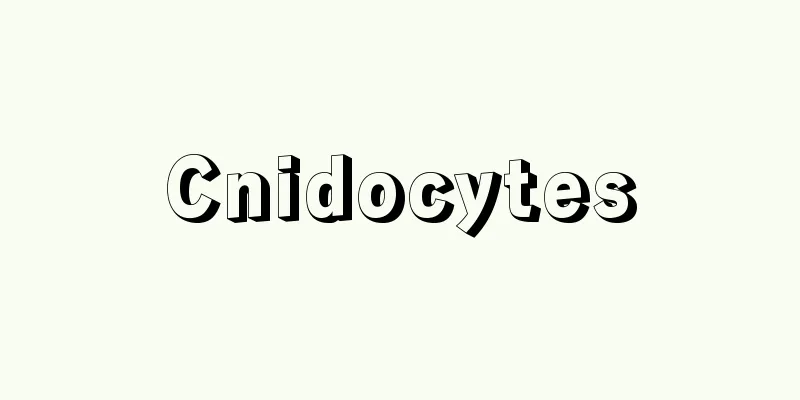Cnidocytes

|
Microscopic structures present in individuals of all species in all classes of the phylum Coelenterata except Ctenomedusa (Hydrozoa, Scyphozoa, and Anthozoa). Because there are many cnidocytes in each individual of these animals, the three classes are sometimes lumped together as the phylum Cnidaria in animal classification. Cnidocytes play a role in preying on food and defending against predators. Therefore, when humans are stung by jellyfish, it is due to the action of these nematocysts present inside the jellyfish's body, but as mentioned above, cnidocytes are not only found in so-called "stinging jellyfish." Nematocysts are cellular organelles contained individually within ectodermal cells called cnidocytes that are scattered throughout the body's tissues; they are generally ovoid or spherical, but some are curved in an irregular spiral, and about 30 different shapes of nematocysts are distinguished. The most common type, called the penetrating nematocyst (also called the common nematocyst), has a long, hollow stinging thread wound inside the cell, and when it receives some kind of stimulus, this stinging thread reverses and comes out, instantly piercing the body of the host animal and injecting the venom inside the cell like a syringe. Once fired, the nematocyst does not return to its original shape, and is a disposable cellular organelle. Although there are still many unknowns regarding the mechanism by which nematocysts are discharged, it is generally believed that the nematocysts have a kind of clasp that holds them back from being discharged, and that discharge occurs when this clasp is released by some kind of stimulus, and various mechanical, electrical, and chemical stimuli have been experimentally elucidated as the stimuli that cause this. The venom components in the nematocysts generally differ depending on the type of coelenterate. Various biogenic amines have been known to be these components, but recently it has been said that peptides are the main component. [Mayumi Yamada] [References] |Source: Shogakukan Encyclopedia Nipponica About Encyclopedia Nipponica Information | Legend |
|
腔腸(こうちょう)動物門のうち、クシクラゲ綱を除くほかのすべての綱(ヒドロ虫綱、ハチクラゲ綱、花虫(かちゅう)綱)の、全種の個体に存在する顕微鏡的な大きさの構造物。刺胞はこれらの動物の1個体中に多数存在するので、動物分類上、前記の3綱を一括して刺胞動物門とすることがある。刺胞は食物の捕食や外敵に対しての防衛の役目をもっている。したがって、ヒトがクラゲに刺されるというのは、そのクラゲの体内に存在するこの刺胞の働きによるものであるが、前述のように刺胞はいわゆる「刺すクラゲ」だけにみられるものではない。 刺胞は体内の組織中に散在する刺細胞とよばれる外胚葉(はいよう)性の細胞内に1個ずつ含まれている細胞器官で、一般には卵形あるいは球形であるが、なかには不規則な螺旋(らせん)状に曲がっているものもあり、これら刺胞には約30種類ほどの形が区別されている。もっとも普通の貫通刺胞(普通刺胞ともいう)とよばれるものでは、その胞内には1本の長い中空の刺糸が巻き込まれて内蔵されており、なんらかの刺激を受けると、この刺糸が反転して外に出て、瞬時に相手の動物の体内に突き刺さり、注射器のように胞内の毒液が相手の体内に注射される。刺胞は一度発射するとふたたび元へ戻ることはなく、使い捨ての細胞器官である。刺胞が発射される機構についてはまだ不明の点も多いが、一般には、刺胞にはその発射を抑えている留め金のようなものがあり、その留め金がなんらかの刺激によって外されると発射がおこると考えられており、その刺激として種々の機械的・電気的・化学的刺激などが、実験的に明らかにされている。刺胞内の毒液成分は一般に腔腸動物の種類によって異なっている。種々の生体アミン類がこの成分として知られてきたが、最近ではペプチド系のものが主体であるといわれている。 [山田真弓] [参照項目] |出典 小学館 日本大百科全書(ニッポニカ)日本大百科全書(ニッポニカ)について 情報 | 凡例 |
Recommend
Simple
…The Book of Rites, Monthly Orders, describes a r...
Aratu - Aratu
...Large ships can dock at the port. Industrial p...
Long dress - Kisenaga
…For the history of the development of armor in a...
Discounting of bills
Also simply called "discount." A type of...
Sefuri [village] - Sefuri
A village in Kanzaki County, northeastern Saga Pre...
"The Book of Crab" - Kani no Hon
...Gutzmuth and others worked as teachers at his ...
Stereocaulon japonicum (English spelling)
… [Hiroyuki Kashiwatani]. … *Some of the terminol...
Phasianus soemmerringii intermedius (English spelling) Phasianus soemmerringii intermedius
…[Ryozo Kakizawa]. … *Some of the terminology tha...
Dew - Dew
On clear nights, especially in the early morning,...
Sculpin - Sculpin
It refers to a general term for fish belonging to ...
Descriptive oceanography
...However, many people use the terms interchange...
Achondroplasia - Achondroplasia
Also known as achondroplasia and fetal chondrodysp...
Local anesthesia - local anesthesia
This is a method of reversibly blocking the condu...
Echizen sickle
Sickles have been produced since the Middle Ages ...
bek
…A title meaning "chief" or "ruler...









